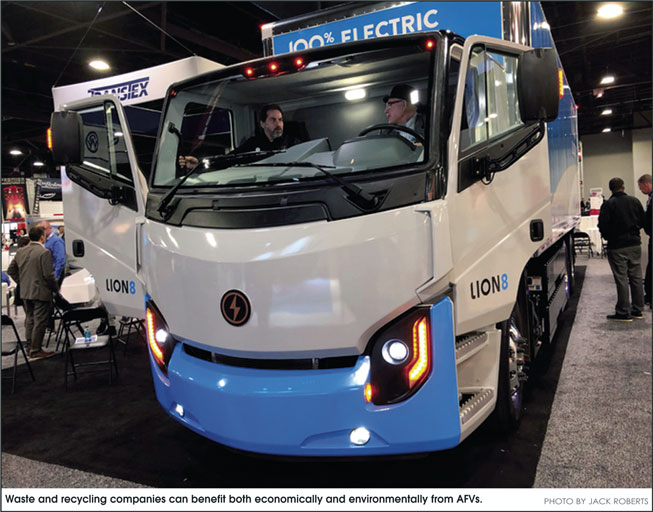by MAURA KELLER
As the waste and recycling industry continue their efforts to be ecologically aware, the type of waste and recycling vehicles being driven are changing.

As alternative vehicles and fuels are making inroads in the industry, more and more companies are embracing these technologies.
Going Green
Faced with high energy costs, environmental concerns by consumers, and government regulatory measures, the world’s leading waste vehicle manufacturers are embracing new technological advancements to make today’s waste vehicles more fuel efficient and environmentally friendly than ever before. Electric vehicles are making strides in the waste and recycling industry especially among companies that are eager to “go green”.
“We see great potential and strong demand for alternative fuel vehicles (AFVs) in the waste and recycling industry,” said Gerardo Gimeno, vice president sales, commercial vehicles, Leclanché, a leading provider of high-quality energy storage solutions, based on lithium-ion cell technology. “First, it helps close the loop in sustainability and makes sense given that recycling activity is aimed at reducing emissions – so clearly the vehicles helping collect waste and recyclables should be carbon neutral themselves. Additionally, diesel vehicles are very loud and require extensive maintenance; AFVs, on the other hand, operate silently and their electronics require far less maintenance.”
According to Eric Foellmer, director of marketing at XL Fleet, on average, refuse collection trucks travel 25,000 miles annually and contribute around 1.4 percent of the transportation industry’s overall fuel consumption, reflecting an attractive, high-impact opportunity for the electrification and decarbonization within the commercial and municipal fleet space.
“This market opportunity to help electrify the waste and recycling industry is significant as fleets look to meet ambitious sustainability goals,” Foellmer said. As the demand for sustainable vehicle solutions in this market has grown steadily in recent years, XL Fleet has recently announced partnerships with Curbtender to develop all-electric and plug-in hybrid refuse trucks and Rubicon to accelerate fleet electrification in the waste and recycling industry.
“We are seeing tremendous demand for all-electric, plug-in hybrid, and hybrid electric commercial trucks for use in waste management applications,” Foellmer said.
Kurt Neutgens, president and chief technology officer at Orange EV, said they have seen waste and recycling leaders experience great success using the company’s Pure Electric Yard Trucks (a.k.a. Terminal Tractors, Hostlers, Spotters, etc.) in their operations.
“We find that beyond the hard savings, lower Total Cost of Ownership (TCO), and greatly improved uptime, many customers also have operations that occur within an enclosed or partially enclosed facility which amplifies the benefit to employees,” Neutgens said. The Orange EV yard trucks provide fume free and emissions free operation that can be operated safely in 100 percent enclosed facilities, as well as in transfer stations, recycling yards, pallet secondary markets and landfills.
As Neutgens explained, electric vehicles (EVs) offer a wealth of benefits including significantly reducing cost, improving uptime and reduced emissions and diesel fumes in local neighborhoods and globally. In addition, EVs reduce noise pollution for on-site personnel and local communities, offer improved safety versus diesels, including approximately 50 percent shorter stopping distances, and feature a longer expected life of the vehicle before significant re-investment.
Gimeno said waste and recycling companies can benefit both economically and environmentally from AFVs. “Currently, hybrid or all-electric vehicles in this market have a positive cost impact (ROI) in five to six years,” Gimeno said. “All-electric vehicles require less maintenance and upkeep compared to diesel vehicles. They don’t require an exhaust system, turbo replacement or oil change and the vehicles’ brake pads last longer due to regenerative braking.”
AFVs also produce less CO2, CO and NOx than diesel-powered vehicles. For example, on Class Seven water tank trucks, a vehicle can require 100 to 120 kWh daily of energy instead of some 60 to 80 gallons of fuel – a cost savings of as much as 90 percent daily. Additionally, AFVs are less noisy than diesel-powered garbage trucks. This means fewer complaints from sleeping residents at 8 a.m.
CNG Vehicles
Electric vehicles aside, another alternative vehicle technology is compressed natural gas (CNG) engines. Autocar first introduced CNG to the refuse truck market in 2004. In fact, Autocar was the very first OEM to offer CNG refuse collection and recycling engines in their trucks and approximately 60 percent of the trucks they sell are CNG, making Autocar the largest supplier of Class 8 cabover CNG trucks across all industries.
“For years, municipalities and private enterprises across North America have expanded their refuse and recycling fleets to alternative fuel options,” said Tim Thornton, vice president and general manager refuse at Autocar Truck. “The fuel cost differential primarily drives this change as well as new environmental laws and Americans’ drive to reduce carbon emissions and convert trucks to renewable energy.”
With the adoption of CNG, the waste and recycling industry became more energy independent, sustainable and environmentally conscious. Plus, waste hauling companies realized the positive financial impact of CNG.
As Thornton pointed out, according to the U.S. Department of Energy, refuse fleets that use CNG saved an average of 50 percent on their fuel costs, which resulted in an annual savings of $13,000 per truck, not to mention the additional savings in tax credits, weight exemptions, grants, rebates or vouchers. “Time and again, CNG results in significantly lower – and more predictable – operating costs, less noise, better rear visibility and the “green” badge of honor their customers appreciate,” Thornton said.
He also believes fleet owners, large and small, will need to overcome the total upfront cost of building the infrastructure to support the technology. In addition to the infrastructure costs, the chassis costs are often times more expensive until they get established.
“For some owners, it’s difficult to distinguish between procurement capital and operating capital,” Thornton said. “The return on investment of these vehicles will be over the lifecycle and won’t be realized at the time of purchase unless subsidies are available to offset the startup costs.”
Ongoing Focus
New technologies and innovative products can keep any industry fresh. And the waste and recycling industry is no exception. As more technology becomes available, alternative fuel vehicles will continue to grow and initial vehicle costs will decrease in relation to conventional fuel vehicles.
Foellmer sees an incredible opportunity in the waste management and recycling industry as companies in this space are going to increasingly look to electrifying their vehicles and driving tangible sustainability success across their businesses and operations.
Of course, the transition to alternative fuels and subsequent alternative vehicles will require an upfront investment of time and money, especially if a company requires a large fleet. In addition, Gimeno said that fleet operators will need to buy new vehicles or retrofit existing vehicles and then install the required charging infrastructure. Additionally, personnel will need to be trained to service battery electric vehicles instead of internal combustion engine vehicles.
“Sites are concerned that the electrical infrastructure will be very expensive. But most fleets find that it is much less expensive than they thought,” Neutgens said. While large deployments may require electrical upgrades, most sites already have the electrical infrastructure needed to deploy several EV trucks.
Thornton is excited about the future role alternative vehicles will play in the waste and recycling industry. “The majority of truck fleets plan to be fully electric or use renewable energy by 2030. Just as heavy-duty CNG trucks were, alternative fuel vehicles are the future.”
Industry experts agree that alternative fuel use is just in its infancy, therefore education in key. And while alternative fuel technology is still relatively new, it is no longer a boutique product only available to certain segments of the industry.
State incentives for alternative fuels and vehicles have also helped spur growth and adoption in many regions. The Alternative Fuels Data Center collects up-to-date information on available incentives for all alternative fuels, and can be a good resource in indicating whether a state or region is primed for growth. Also, it offers an up-to-date database of the various tax incentives, rebates, and credits available on a state-by-state basis for fuel producers, retailers, and vehicle owners.
Published in the August 2021 Edition







